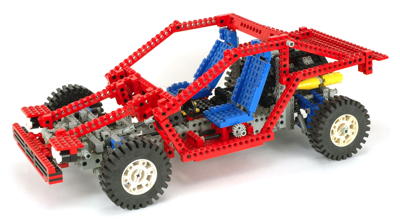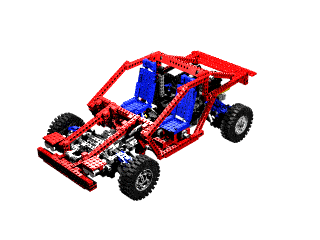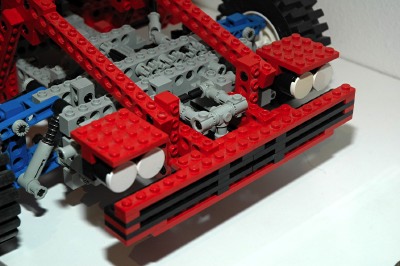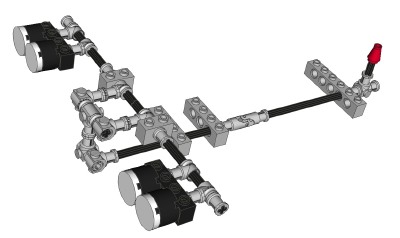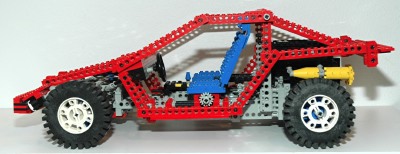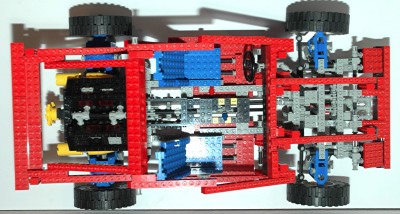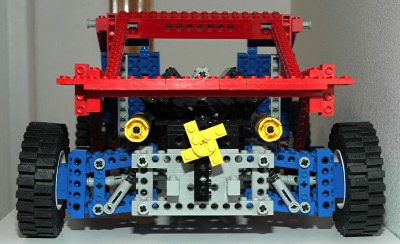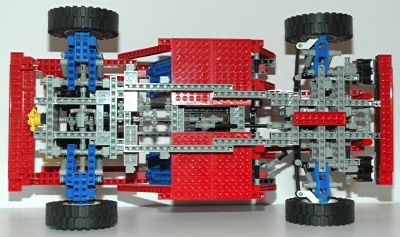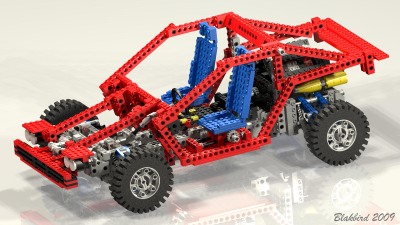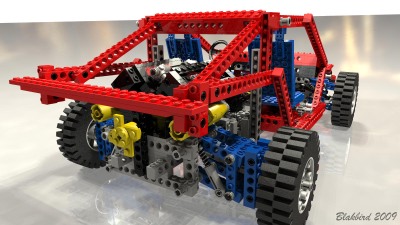Features
|
|
Steering
The front wheels can be steered using a new wheel at the driver's
position. The wheel axle passes through a pair of universal
joints, then through a triplet of 16 tooth spur gears. Finally, a
pinion drives a rack.
The rack uses the new ball joints at each end to attach to new tie
rods. The tie rods connect to the new steering arms with more
ball joints. The steering arm itself pivots on upper and lower
king pins which fit into sockets in the control arms.
In this Technic set, the steering employs the
Ackerman Principle based on the shape of the new steering arms.
You can see in the images that the tie rod attachments are not directly
behind the kingpins, but are
inboard. The result of this is that the wheel on the inside of
the turn is rotated more sharply than the wheel on the outside, which
is exactly what is required for a turning in a proper circle without
skidding.
|
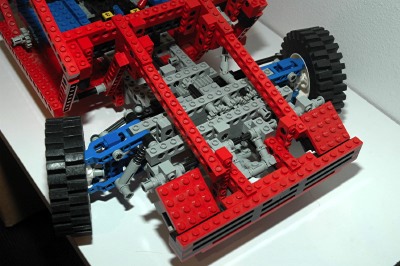
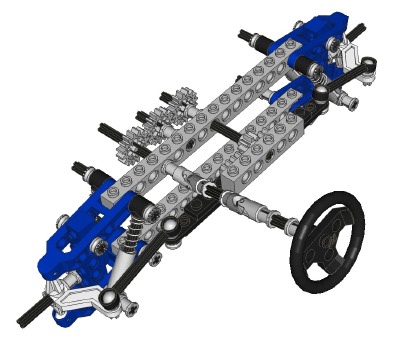
Click for an animation of the
steering in motion.
|
|
Engine and
Transmission
This set features a rear mounted V-4 engine. This is the first
set to feature an engine in a V configuration other than the special
engines set (858).
The engine uses the offset axle holes of the 24 tooth gears to make a
crankshaft. Connectors placed end to end and clocked 90 degrees
form rods which connect to 4 specialized 2x2 square pistons. The
"cylinders" are actually square. Each pair of opposing cylinders
shares a common crank pin.
The engine also has a number of aesthetic features such as a pair of
exhaust manifolds.
Ahead of the engine is a 3 speed gearbox / transmission. The color
coded computer image shows the configuration in each gear. The
version on the right is in neutral. The middle axle translates
forward and back which allows different gears to mesh. The upper
axle with the 1/2 bushing goes to the engine. The differential
drives the wheels.
In 3rd gear (green), the path to the wheels
is (16/16) x (16/24) x (28/14) = 1.33:1. In 2nd gear (blue), the
path to the wheels
is (16/16) x (24/16) x (28/14) = 3:1. In 1st gear (red), the path
to the wheels
is (24/8) x (16/24) x (28/14) = 4:1.
The gearbox is not synchronized in any way, so it is difficult to shift
gears since they tend not to be aligned.
|
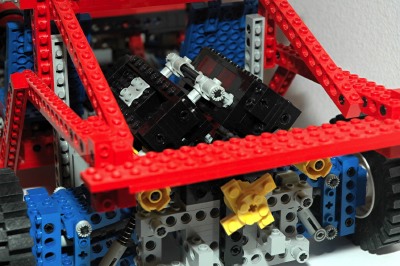
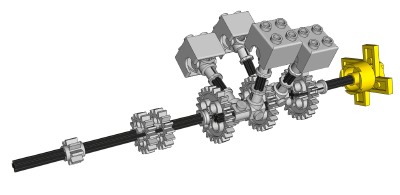
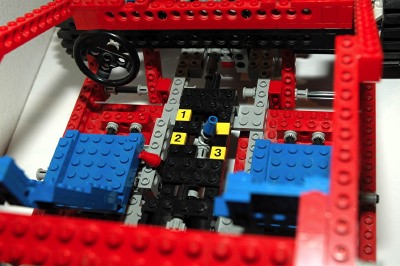
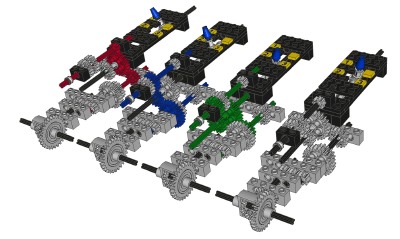
Click for an animation of the
engine
in motion.
Click for an animation of the
transmission shifting.
|
|
Suspension
This is the first LEGO® set with suspension on all 4
wheels, and the first to have suspension on a steerable axle. All
four wheels have independent suspension.
The front suspension uses the new control arms parts (blue) and
steering arms (white). Upper and lower ball joints form king
pins, making this a double wishbone suspension. Because it is a
four bar linkage, the wheel stays perpendicular to the ground
throughout its travel. A pair of shock absorbers provide
support. An extra vertical 6L beam helps support the four bar
linkage so that not too much vertical stress is put on the steering arm.
The rear suspension could have also used the new control arms, but
instead forms the control arms out of four beams. An assembly of
plates and beams forms the hub which pivots on longitudinal
axles. A pair of vertical two blade rotor parts are used to
support the four bar linkage. Power is driven through a pair of
universal joints on each side. The pivot point of the u-joints is
carefully aligned with the pivot points of the suspension.
|
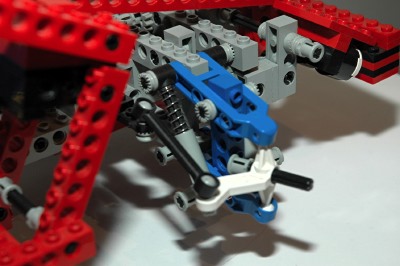
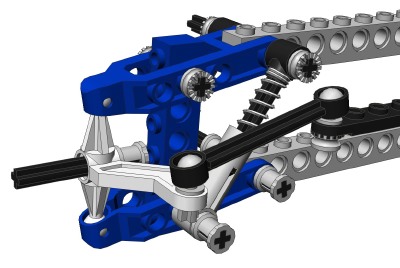
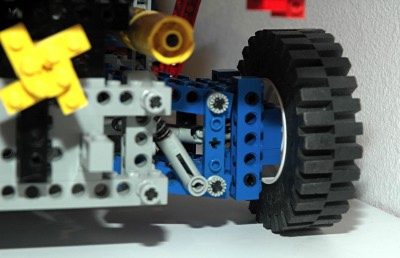
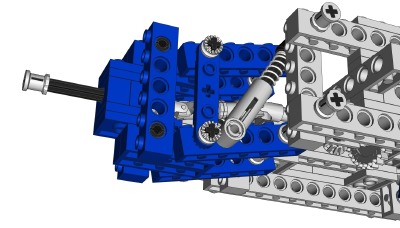
Click for an animation of the
front suspension
in motion.
Click for an animation of the
rear suspension
in motion.
|
|
Differential
This set uses a rear differential gear. It
incorporates a built in 28 tooth ring gear which can work either as a
bevel or a spur, similar to the 24 tooth crown gear. It is made
to house 3 of the 14 tooth bevel gears. One is on each axle,
and one planet gear in the middle allows the axles to turn at different
rates. This addition results in very smooth turns for this model.
|
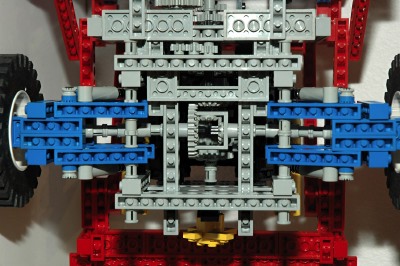
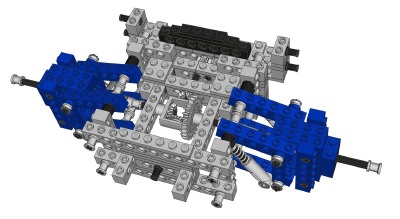
Click for an animation of the
differential
in motion. |
|
Seats
The seats are adjustable in both position and recline angle. A
pair of longitudinal axles support each seat and
allow it to translate forward and back. A rack gear runs parallel
to the axles. A pinion gear attached to the seat can be turned
via a crank, driving the seat forward (see computer image and
animation).
In addition to the ability to adjust the position of the seats, these
seats also can be reclined! Recline is based on simple finger
hinges which tend to not be tight enough to support the weight of the
seat back if the angle is more than a few degrees.
There are no rear seats.
|
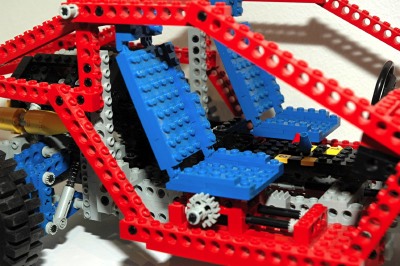
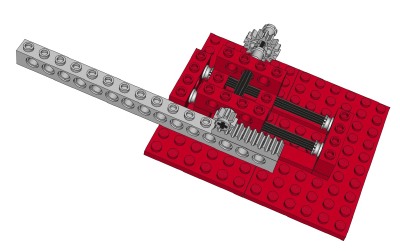
Click for an animation of the seats
in motion.
|
|
Headlights
This is not only the first auto chassis with a body, but the front end
features retractable headlights. A lever in the cabin pushes an
axle forward and back (see computer image). This axle turns a
crank which pushes up the headlights about 45 degrees.
|
|
|
Wheels and Tires
This set uses four foam 24x43 tires and wheels, the biggest
foam tire that LEGO® made. This is the only set to
ever have these wheels in white.
|

|

